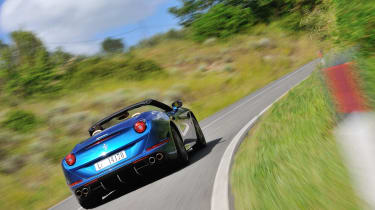Ferrari California T review - Is the California T a true Ferrari? - Ride and Handling
A capable, fast and polished GT - the Ferrari California T is still lacking in that intangible Ferrari magic
Ride and handling
The first impression is that the California T rides superbly. Road surface imperfections are rounded off with a real pliancy both in Comfort and even in Sport mode. It’s a reminder that the California T needs to be approached as a GT car rather than a full-on sports car. Expect Ferrari 458 levels of agility and you’ll think it lazy, but keep in mind its intended purpose you’ll find very much to commend about its dynamic performance.
The steering initially feels unnaturally quick. It’s actually not quite as hyperactive as a 458’s helm, for instance, but for the first few miles you do find yourself dialing in a little too much lock for a given corner. Very soon the driver recalibrates to the steering’s rate of response and it becomes natural and intuitive, though. The steering always feels a little remote, however, with only a vague sense of connectivity once the chassis is really loaded up.
With 53 per cent of its weight over the rear axle the California T doesn’t feel anything like as front heavy as the layout and dimensions might suggest. That gives it both a sense of agility on turn in and a neutral balance mid-corner.
More reviews
There is almost no perceptible natural understeer at road speeds. Rather than pushing on at turn in, the car instead collapses a little onto its rear axle. The rear anti-roll bar is soft, which gives the California T huge traction at corner exit, but it also means the driver must dial back a little to accommodate that initial roll. The firmer chassis mode corrects this slightly, though not entirely.
The optional magnetorheological dampers can be set to an intermediary ‘bumpy road’ mode when the manettino is set to Sport. This gives the chassis an impressive secondary ride over smaller lumps and bumps, isolating the occupants from the road surface while still retaining enough body control when the corners come thick and fast. That mode will work superbly in the UK.
Ferrari limits the torque through the gears, which benefits traction and drivability. Unleashing the full amount of torque in second gear at corner exit would simply bonfire the rear tyres. Instead, it’ll only be provoked into modest slides away from the apex under full throttle in second gear, giving the car that sense of fun and agility that we expect of sports cars, but perhaps not of GTs.
This new V8 is as impressive as forced induced engines come and the gearbox is remarkable; each new gear seems to bang in before you’ve even fully pulled the paddle. There is no discernable turbo lag and the top end is just as useable as the mid-range, but there aren’t, as we should expect, the top end fireworks that we so love Ferrari’s normally aspirated engines for. There isn’t the same aural excitement either, despite the flat-plane crank and the equal length exhaust header pipes, although at very low engine speeds this new V8 does emit a crisp, hollow exhaust note that calls to mind a 458.
Ferrari have sharpened up the way the California drives with the Handling Speciale pack, or HS for short. Don’t let the word Speciale fool you though, the HS is not a whole separate model but a tweaked California.To improve the California’s dynamics Ferrari have added new front and rear spring rates and revised magnetic dampers. The HS pack doesn’t bestow the California with any more power but it does add a new exhaust system that’s louder and features a crisper, sharper tone. The gearbox has been recalibrated too with quicker shifts. The traction control system has been fettled too, however there’s no intermediate setting. There’s either on, which is very restricting, or off.




